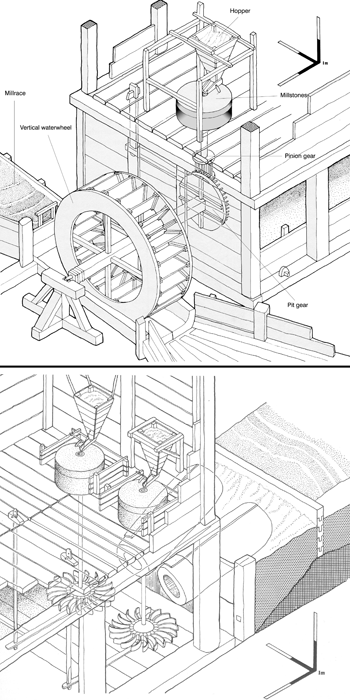Technology
Published in Issue 2 (March/April 2014), Volume 22
Above: Conjectural reconstructions of the vertical-wheeled watermill (top) and the horizontal-wheeled watermill (bottom) at Little Island, Co. Cork. (Colin Rynne)
The Irish had borrowed much from the Romans—brooches, pins, barrel padlocks, sickles, ploughshares, the furnace and eventually the watermill. Such borrowing was not passive. Recent excavations throw light on this. A crop-processing complex was discovered at Curtaun, Co. Galway (during work on the N18 Gort to Crusheen road scheme). The grain-drying kiln was close to a large ringfort and was stone-lined. It has multiple flues and was rebuilt on a number of occasions. It was clear that the farmer had experimented to achieve optimal results.
More watermills have been discovered in Munster for this early period than in the rest of Europe. The mill at High Island in County Galway with its reservoir, millpond and wheelhouse is just one of many that allow us to judge their sophistication. The most remarkable of all are the tidal mills discovered at the monastery of Nendrum in County Antrim. The earliest excavated tidal mill in the world was here, dated to between 619 and 621. A second dated from the late seventh or early eighth century and a third from 787/8. The first had a pond with a surface area of 6,500 square metres. It was retained behind a massive embankment of highly complex construction. Knowledge of waterproofing clays, of materials in timber, wattle and stone for stabilising was in evidence. The massive sandstone flume of Mill 3 is unparalleled. It has been estimated that theoretically it could have produced energy of between 1,700 and 2,250 kilowatt-hours per annum. The tidal mill at Little Island east of Cork city had a twin-flume horizontal-wheeled mill dating from c. 630 with a vertical undershot waterwheel beside it.
The organisation of labour for such projects would have been a formidable undertaking. The mid-seventh-century ‘life’ of St Brigit has much to tell us about the organisation of labour for the construction of a large road across a swamp leading to a river where there was probably a bridge. The king of the province of Leinster ordered its construction, and it is likely that it was of major benefit to Kildare. A similar road and wooden bridge have been excavated downstream of the monastery of Clonmacnoise, dating from c. 804. The bridge was at least 120m long and 5m wide—the road that led to it from the west was 3–5m wide and could be traced for approximately 2.4km. The only comparable bridge was that built in 979–80 by Harald Bluetooth over the Vejle River in Denmark.
















